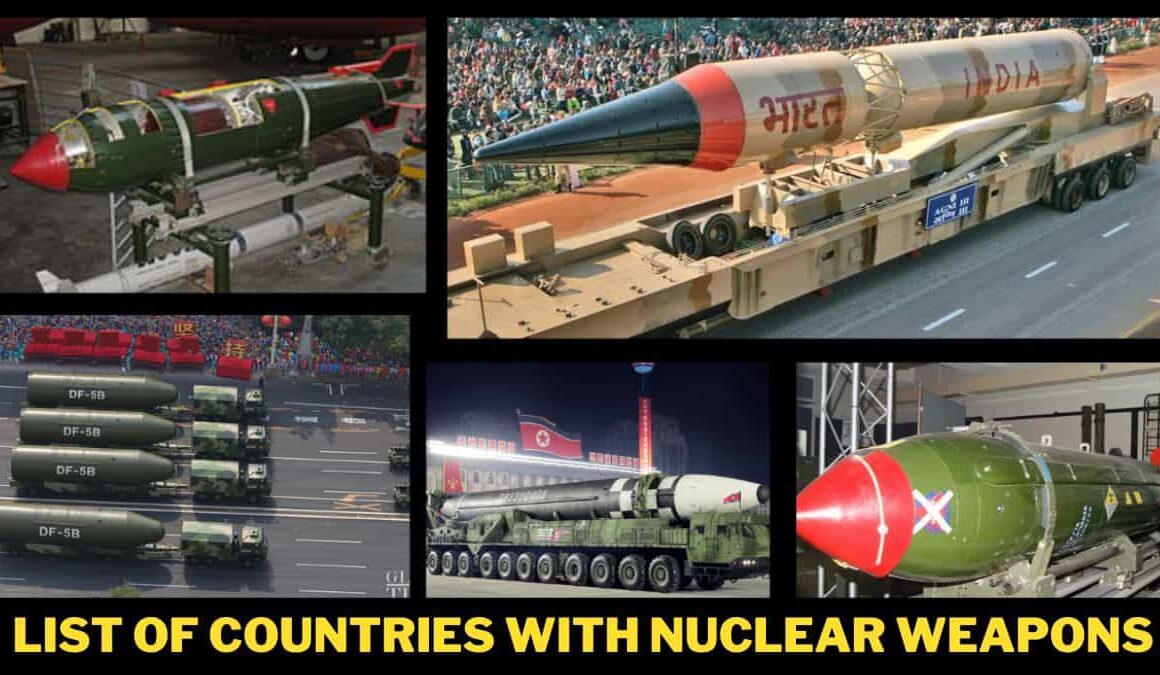If you’ve ever wondered which corners of Europe are packing some serious firepower under the nuclear umbrella, you’re not alone. In a world where headlines scream about global tensions, it’s natural to want the straight facts on something as heavy as nuclear weapons. Today, we’re diving deep into the full list of European countries with nuclear weapons—think France’s sleek submarines, the UK’s Trident missiles, Russia’s massive arsenal, and even those U.S. bombs tucked away in NATO bunkers across the continent. I’ll keep it real, conversational, and packed with the info you need, all while breaking down the history, the tech, and what it means for us in 2025.
What Exactly Are We Talking About? Nuclear Weapons in Europe Explained
Picture this: a device so powerful it could level a city in seconds, born from the genius (and horror) of splitting atoms. Nuclear weapons come in two flavors—fission bombs (like the old Hiroshima type) and fusion ones (hydrogen bombs, way more destructive). In Europe, we’re dealing with a mix of strategic beasts for long-range strikes and tactical ones for battlefield use.
Europe isn’t a nuclear free-for-all. Only a handful of countries own them outright, while others host them under alliances like NATO. As of October 2025, the global tally hovers around 12,300 warheads, with Europe holding a chunky slice—about 1,500 or so, depending on how you count retired ones waiting to be dismantled. That’s down from Cold War peaks of over 70,000, thanks to treaties like New START, but tensions are rising again.
Key distinction: “Possessing” means owning and controlling them. “Hosting” means storing someone else’s on your soil, ready for a rainy day. Got it? Good. Now, onto the list.
The Full List: European Countries with Nuclear Weapons in 2025
Here’s the rundown on Europe’s nuclear club. I’ll split it into owners and hosts for clarity, because lumping them together can get confusing.
1. Owners: The Big Three in Europe
Only three European nations call the shots on their own nukes. They’re all NATO members (well, two of them), and their arsenals are the backbone of the continent’s deterrence.
- France: The independent powerhouse. France has about 290 warheads, mostly on submarines and air-launched missiles. Their Force de Frappe (strike force) is all about sovereignty—no sharing unless they say so. In March 2025, President Macron floated extending protection to other Europeans, but France keeps the keys. Bases? Think Île Longue near Brest and airfields like Istres.
- United Kingdom: Our friends across the Channel pack around 225 warheads, mostly Trident SLBMs (submarine-launched ballistic missiles) on Vanguard-class subs. At the 2025 NATO summit, they announced F-35 jets that can carry U.S. bombs, beefing up air delivery. Faslane in Scotland is the hub—those subs are always at sea, one ready to go 24/7.
- Russia: The elephant in the room (or Kaliningrad). With 5,977 warheads total, Russia’s got the world’s largest stockpile, including 1,912 tactical ones. European bases? Think storage sites near Moscow and forward deployments in Belarus since 2023. They’re the counterweight to NATO, and yeah, Putin’s rattled the saber more than once lately.
That’s it for owners. No one else in Europe has their own—South Africa gave theirs up in the ’90s, and former Soviet states like Ukraine handed back Soviet-era nukes post-1991.
2. Hosts: NATO’s Nuclear Sharing Partners
Enter NATO’s nuclear sharing program—a Cold War relic where the U.S. parks about 100 B61 gravity bombs at allied bases. These aren’t “theirs,” but host nations train to deliver them with F-35s or Tornados if the president gives the nod. It’s all about burden-sharing and deterrence.
As of 2025, five European countries (plus Turkey, if we’re counting it as transcontinental) host these:
- Belgium: Kleine Brogel Air Base holds around 10-20 bombs. Belgian F-16s (soon F-35s) are certified for the job. Public protests? Ongoing, but it’s stayed put.
- Germany: Büchel Air Base is home to 10-20 warheads. Tornado jets for now, F-35s incoming. Germany’s hosted U.S. nukes since 1955—longest streak ever.
- Italy: Aviano and Ghedi bases store about 40 combined. Italian Tornados and soon F-35s keep ’em company. Strategic spot near the Adriatic.
- Netherlands: Volkel Air Base has 10-20. Dutch F-16s are pros at this, with F-35s on deck. Quiet town, big secret.
- Turkey: Incirlik Air Base, about 20 bombs. Tensions with the U.S. have sparked relocation talks, but they’re still there in 2025.
Bonus: The UK hosts some too at Lakenheath—25-30 redeployed in 2025. And whispers of more in Poland? President Nawrocki pushed for sharing in September 2025, but no dice yet.
Full list table for quick reference:
| Country | Status | Estimated Warheads | Key Bases |
|---|---|---|---|
| France | Owner | 290 | Île Longue, Istres |
| UK | Owner | 225 | Faslane, Lakenheath (US-hosted) |
| Russia | Owner | 5,977 (total) | Various, incl. Belarus deployments |
| Belgium | Host | 10-20 (US) | Kleine Brogel |
| Germany | Host | 10-20 (US) | Büchel |
| Italy | Host | ~40 (US) | Aviano, Ghedi |
| Netherlands | Host | 10-20 (US) | Volkel |
| Turkey | Host | ~20 (US) | Incirlik |
A Quick History Lesson: How Europe Got Nuked Up
Flashback to 1945: The U.S. drops bombs on Japan, and the world changes forever. Fast-forward to the 1950s—Cold War chills Europe, and Eisenhower ships the first U.S. nukes across the Atlantic in 1954. By 1971, 7,300 warheads dotted the continent. France goes solo in 1960 with its first test, the UK had theirs in ’52 (thanks, Manhattan Project collab).
Russia (as the USSR) was right there from ’49. Post-Wall fall in 1989, arsenals shrink—90% gone by now. But 2022’s Ukraine invasion? It’s reignited debates. Russia’s moved tactical nukes to Belarus, and NATO’s doubling down on exercises like Steadfast Noon.
Fun fact: No nukes used in anger since ’45, but close calls—like the 1962 Cuban Missile Crisis—remind us how fragile this is.
NATO Nuclear Sharing: The Glue Holding It Together
If owning nukes is the headline, NATO sharing is the fine print. Started in the ’60s, it’s got 100 B61s spread across those military bases, guarded by U.S. airmen but flyable by allies. Why? Deterrence. If Russia blinks, these show we’re all in.
Training’s intense—pilots from Belgium to Turkey practice “dummy” drops yearly. And with F-35 upgrades, it’s getting stealthier. But critics say it’s provocative; Russia calls it aggressive encirclement.
France sits outside this, but Macron’s 2025 musings could bridge that gap. Poland’s eyeing in too—smart, given their border.
Spotlight: France’s Nuclear Might
France doesn’t mess around. Their 290 warheads are split: 48 on each of four Triomphant-class subs (M51 missiles, range 6,000+ km) and air-launched ASMP-As on Rafales. Total cost? Billions, but it’s their “vital interests” shield.
In 2025, amid U.S. election jitters, Macron’s offer to “Europeanize” deterrence has folks buzzing. Would Paris risk Paris for Berlin? That’s the trust question.
Spotlight: The UK’s Submarine Shadow
The Brits keep it simple: continuous at-sea deterrence (CASD). One of four Dreadnought subs (coming soon) lurks in the Atlantic, 16 missiles, up to 8 warheads each. Land-based? Mostly gone, but Lakenheath’s U.S. stash adds punch.
2025’s F-35 buy signals air options, but subs are king—unfindable, unstoppable.
Spotlight: Russia’s European Arsenal
Russia’s no joke: ICBMs, subs, bombers, and tactical Iskanders. In Europe, focus on Kaliningrad and Belarus With 1,588 deployed, it’s a staring contest with NATO. Recent Oreshnik missile tests? Escalation vibes.
ALSO READ: Top 10 Strongest Militay in Europe
Spotlight: U.S. Bombs in Europe—The Shared Secret
Those 100 B61s? Low-yield (0.3-170 kt), gravity drops from 30,000 feet. Stored in WS3 vaults, Permissive Action Links keep Uncle Sam in control. Hosts like Germany debate withdrawal, but Russia’s moves say “stay.”
Modernization: B61-12s rolling out by late 2025, tail kits for precision.
The 2025 Landscape: What’s New and What’s Worrisome
October 2025 snapshot: Global stockpiles steady at 12,331, but China’s growth (600 warheads) and Russia’s Belarus play amp Europe’s anxiety. NATO’s summit reaffirmed sharing; Poland’s push highlights eastern flanks.
Treaties? New START expires 2026—renewal talks stalled. Iran’s “snapback” sanctions in September add fuel, indirectly pressuring Europe. Public opinion? Polls show 60% of Germans want U.S. nukes out, but security trumps.
Implications: Deterrence, Risks, and the Road Ahead
These weapons deter aggression—Russia thinks twice because of NATO’s umbrella. But risks? Accident, theft, escalation. A tactical nuke in Ukraine could spiral.
Future? More European buy-in, maybe French-UK pooling. Arms control revival? Fingers crossed. Europe’s learning: reliance on U.S. has limits; self-reliance calls.
Bottom line: Nuclear weapons in Europe are fewer, but sharper. They buy peace, but at what cost?
Wrapping It Up: Your Take on Europe’s Nuclear Club
We’ve covered the full list of European countries with nuclear weapons—from owners to hosts, history to headlines. It’s a tense tapestry, but knowledge is power. What surprises you most? Drop a comment—France’s independence? Russia’s shadow? Let’s chat.
Stay informed, stay safe. Until next time.






